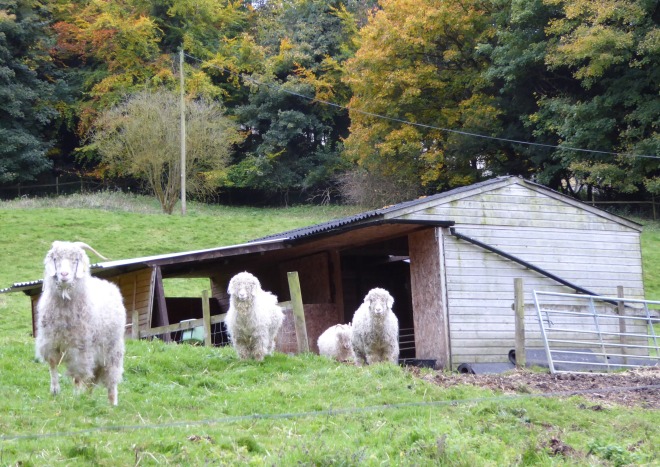
Cotswold Lions at Prinknash Abbey farm
‘In Europe the best wool is English and in England the best wool is Cotswold’
(12th century saying).
This week I am thinking about texture.
There are two types of texture, actual texture which you can feel or touch, and visual texture which uses marks to give the illusion of a textured surface. It fascinates me that the word texture originated from from the Latin textilis ~ woven, from texere ~ to weave and the 17th century word Textile has the same root. A textile is literally ‘that which has been woven’. So this weekend I set out to learn more about it.
There can’t be a more random selection of textures than stone, wool, water, grass and brass; however, there is a link! And it is at the heart of this beautiful area I live in called the Cotswolds.
The Cotswold land is ideal for sheep grazing and in medieval times the Abbeys and Monasteries kept huge flocks of the native breed, which was, and still is, known as the Cotswold Lion, because it has a long shaggy mane over its eyes. These are stocky animals that breed well and grow quickly. Their wool is so long, fine, white and soft that it was known as the ‘golden fleece’ ~ because of the wealth it created, not the colour.
From the earliest times the wool itself was traded, but by the middle ages whole cottage industries grew up to process the wool into cloth. The clothier and his family prepared the raw wool then gave it to his neighbours to be spun by the women and children. It was then woven by men in their homes. The weavers’ cottages had long, low windows in order to give maximum light to the looms. After processing the cloth was extremely dense and almost waterproof due to the nap, which was ideal for the military, huntsmen and landowners.
The merchants who traded in this fine cloth became extremely wealthy. They used their wealth to build wonderful houses out of the local Cotswold stone and to build and furnish exquisite churches in the market towns and villages, with stained glass, stone carvings and brasses.
Yes, the rolling fields, honey coloured stone cottages, ancient mills and beautiful churches that make up our landscape are all here because of sheep. The names of the villages such as Sheepscombe reflect the trade, and even our pubs and inns like the Fleece or the Ram are reminiscent of the wool trade.
I visited the church of St. Peter and St. Paul at Northleach today. It is one of the largest and finest wool churches in England. There are some fascinating brasses in this church with images of the merchants with sacks of wool or sheep as their footrest. They date back to the 1400s. One or two of the brasses were particularly interesting as they showed that women could be wealthy merchants too. And, one particularly striking couple had their 15 children shown on the brass!
By the 16th century the industry was moving away from the small towns and villages to be nearer to the Stroud valley where the fast-flowing streams supplied the power to drive the fulling mills. In its heyday, there were around 200 mills in the Stroud valley and many of them are still standing today. They are converted for other industrial uses now or renovated into rather swish apartments.
I learned some fascinating facts today. Who knew that subsequent to the ‘Burial in Wool acts of 1667 and 1668’, all bodies had to be buried in wool unless they died of plague. This law was only repealed in 1814. It stated that,
“No corps should be buried in anything other than what is made of sheep’s wool only; or put into any coffin lined or faced with any material but sheep’s wool, on pain of forfeiture of £5.”
The old saying – “You can’t pull the wool over my eyes”, came from being buried in a shroud of wool, and meant that “I am not dead!”
You may know that there is a large wool-stuffed cushion or seat covered in red cloth in the House of Lords. This is called the Woolsack and is where the Lord Speaker sits during Parliamentary proceedings with the Mace on the woolsack behind him. It was introduced by King Edward III (1327-77) and originally stuffed with English wool as a reminder of England’s traditional source of wealth – the wool trade. There is also a larger woolsack where senior Judges sit during the State Opening of Parliament.
Here are some photos from Northleach where wealthy cloth merchant John Fortey paid for the church renovations
Here are some photos from Bibury where wool was treated on Rack isle
And lastly some photos from Nailsworth where the Fulling Mills refined the texture of the cloth.
And lastly, to the pub, The Fleece at Bretforton!
I could write so much more, but if you are interested I can recommend these very knowledgeable and interesting websites:
http://www.cotswoldjourneys.com/cotswolds-guide/the-cotswolds-wool-trade/
http://stroud-textile.org.uk/history/background-to-the-local-wool-industry/




























Such a great post and wonderful impressions. I wish I’d read this before our visit to the Cotswolds in November. Anyway, it was so lovely, I’m sure we’ll pay it a visit again. Thank you so much for sharing! x
LikeLiked by 1 person
So glad you enjoyed your visit! Do come again x
LikeLike
Love these corners of England I haven’t heard about before. You live in such a beautiful land.
LikeLiked by 2 people
It is gorgeous but the weather is terrible this summer- rain, rain, rain!
LikeLike
How cool, this is the kind of centuries old history we typically don’t have in the US. It is fascinating to me. Lovely photos, too.
LikeLiked by 2 people
Thank you so much for your kind words. Yes we have the history but oh my the weather is atrocious this summer! Although on reflection I would rather have our rain than the heatwave that lots of Europe is experiencing x
LikeLiked by 1 person
Very true! Every place always has a little good and bad mixed, doesn’t it?
LikeLiked by 2 people
Thanks for the gorgeous, entertaining, and informative tour down the lanes and by-lanes of history.
LikeLiked by 2 people
You’re very welcome! One of the things I love about reading other people’s blogs is that I get to see and learn about places I will never see! It is so much more interesting than just looking at a travel mag because you get the local perspective and bits of fascinating information x
LikeLike
Love the background of the saying, “You can’t pull the wool over my head”! I have never heard this. And what lovely photos of a stunning place in the world. We visited the Cotswolds last December, but, alas, didn’t see it all!
LikeLiked by 2 people
Ah you must return as there is so much history to discover and beauty to enjoy x
LikeLiked by 1 person
Fascinating history. Thanks for the tour, as well.
LikeLiked by 2 people
You’re welcome x I enjoyed my day of discovery thanks to WPC!
LikeLike